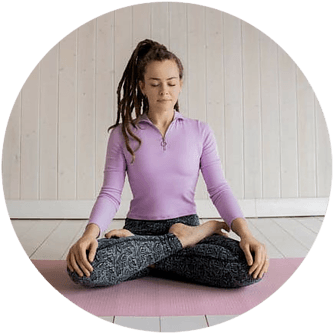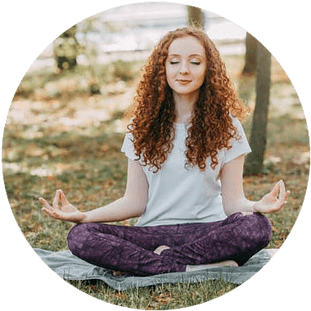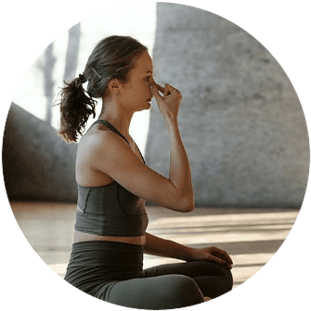When was the last time you took a deep breath? I guess…probably at the end of a long tiring day or you don’t even remember…Right? So what is deep breathing and why it is important?
Deep breathing also called diaphragmatic breathing is essentially a breathing technique used by many to relax tense muscles and ease stress. Once you learn how to deep breathe then you can use it to calm you anywhere, whether you are sitting at your desk or doing work around the house.
“Just Breathe” – This is common advice given by many people when we get stressed or tensed but how many of us actually do this? If you ask me – I have often overlooked this simple advice and it is now I realize that this simple act of breathing which can be done anytime and anywhere is mighty powerful.
Our bodies have the ability to breathe without we having to think about it however if you can deliberately pay attention to your breath especially during the moments of stress or anxiety then you can counter the stress and handle the situation in a much better way. By using the power of breath you can intentionally create a positive physical and emotional change to your life.
Why Does Deep Breathing Work

Deep breathing enables more air to flow into your body and as the supply of oxygen increases to your brain, it activates your nervous system, which in turn promotes a state of calmness.
Think about this – When you are stressed or anxious, your heart rate increases, your blood pressure rises, your breathing becomes shallow and your chest tightens as the lack of oxygen hits your body. You can simply reverse all this by taking few deep breaths during the moments of anxiety because as you breathe deeply, there is an automatic signal/message that goes to your brain to calm down and relax.
The key takeaway or the point to understand over here is that purposeful deep breathing can physically calm your body down if you are feeling stressed or anxious. To understand this point it is important for you to know how deep breathing actually impacts the functioning of your nervous system in a positive way. So let me quickly explain the connection between the breath and the nervous system.
If you try to hold your breath, your body will override your action and force you to let out that breath and start breathing again. This happens because your body’s autonomic nervous system controls your breathing as many other functions in the body.
Your autonomic nervous system runs on an autopilot mode. It is split into two parts. The first part, the sympathetic nervous system that controls your fight-or-flight response. The second part, the parasympathetic nervous system that controls your rest and relaxation response.
These two parts of your nervous system cannot be turned on at the same time, this means if I activate one part the other part will be suppressed. So every time I practice deep breathing I can turn on the second part i.e. parasympathetic nervous system and this, in turn, helps me to relax quickly and respond effectively even in a stressful environment.
Think about this – If you can regularly at periodic intervals during the day practice deep breaths, then you are activating the second part of the nervous system which continuously sends a signal/message to your brain “All is Well”. This means you can stay relaxed and calm throughout the day, even though you may be going through a chaotic environment.
Related Post: Learn How To Unfold The Secret Breath Effortlessly With Pranayama
What Are The Benefits Of Deep Breathing
The breath is the most powerful free tool you have at your disposal for energy generation and overall health. Not breathing properly, leads of less circulation of oxygen in the body and thereby slows down the flow of energy through our system. Breathing correctly is important for your overall well-being. While its benefits are uncountable, here are some important ones that will motivate you to deep breathe.
1. Calms The Nervous System
1:2 breathing practice is the simplest technique to calm your nervous system. In this method, you exhale twice as long as you inhale. For instance: If you inhale for 4 seconds then you exhale for 8 seconds. 1:2 is the ratio of inhaling time to exhale time. You can do it now for about a minute and you will notice your heart rate slows down immediately.
This is the quickest and easiest breathing practice to regulate the motion of lungs and calm the nervous system. As you practice this regularly, you will experience a sense of serenity throughout your day.
2. Helps In Detoxification
You can discard all the detox fads and simply focus on your breath and practice deep breathing to detoxify your body. Oxygen plays a key role in cleansing the body, it helps your body absorb vitamins and nutrients more efficiently, and it actually creates more white blood cells.
By practicing deep breathing at regular intervals you can provide your body a healthy shot of oxygen and by exhaling deeply we eliminate the body waste in the form of carbon dioxide and this naturally leads to detoxification of the body.
3. Improves Your Mood
 If you are feeling low then a natural and easy way to lighten your mood is to focus on breathing. Believe it or not, the way you breathe directly influences your brain’s chemistry. The majority of us experience a lot of mood swings throughout the day, taking a break of few seconds, and practicing breath awareness helps in elevating our moods.
If you are feeling low then a natural and easy way to lighten your mood is to focus on breathing. Believe it or not, the way you breathe directly influences your brain’s chemistry. The majority of us experience a lot of mood swings throughout the day, taking a break of few seconds, and practicing breath awareness helps in elevating our moods.
As you practice deep breathing, the brain releases dopamine, a pleasure-inducing neurochemical which enhances the mood, acts as a pain reliever, and creates a calming effect on the body.
4. Strengthens The Lymphatic System
A peak functioning lymphatic system is key to health and vitality however the sad part is not many people are aware of the importance of it or do not know about it. The lymphatic system includes your bone marrow, spleen, thymus, lymph nodes, and lymphatic vessels that lay beneath the surface of your skin like a web of very thin tubes.
There is one peculiar thing about the lymphatic system, it needs your help to move the fluid through the body because it doesn’t have an automatic pump like the heart, which moves the blood in the circulatory system.
Constant shallow breathing leads to lymphatic congestion, proper practice of deep breathing acts like a pump that helps move fluid through the vessels and lymph nodes. The movement of fluid through the bloodstream dramatically helps in the elimination of toxins from the body.
The Best Deep Breathing Exercises
By now you must be convinced on the part that having a regular breathing practice has multifold benefits. If you are still wondering how to add breathing exercises in your daily routine then here are the three breathing techniques to get started.
1. Equal Breathing

Equal breathing stems from the ancient practice of pranayama yoga and is by far the simplest breathing techniques for beginners. As the name says “Equal Breathing” this technique brings evenness and encourages balance in the body. The objective of this breathing practice is to bring the body to a resting state by focusing on specific counts of equal duration.
How To Practice Equal Breathing
- Sit comfortably on a chair or cross-legged on a yoga mat. Make sure you sit straight, do not slouch your shoulders. Shut your eyes and pay attention to your natural breath.
- When you are ready, begin to inhale through your nose and slowly count in your mind 1-2-3-4.
- As you exhale through your nose count in your mind 4-3-2-1.
- This is the equal duration of inhaling and exhaling which you need to maintain throughout this practice.
2. Diaphragmatic Breathing
Diaphragmatic breathing involves breathing deep into the stomach and fully engaging the diaphragm. This strengthens the diaphragm and helps the lungs work more efficiently. The diaphragm is a large dome-shaped muscle located at the base of the lungs. It helps move air in and out of the lungs.
How To Practice Diaphragmatic Breathing
- If you are practicing Diaphragmatic Breathing for the first time then it is recommended that you practice this by lying down instead of being seated on a chair or on the ground.
- Lie down on a flat surface, you can use pillows under your head and beneath the knees for support and to keep the body in a comfortable position.
- Place one hand on your upper chest and the other one below your rib cage.
- Breathe in through your nose, as you inhale, your stomach pushes forward and you feel the rise of your hand. The hand on the chest remains still.
- Exhale out through pursed lips and let the stomach contract and you fell the hand going downward. Again the hand on the chest should remain still.
3. Alternate Nostril Breathing

Alternate nostril breathing is a simple powerful breathing technique that you can use to quiet your racing mind. Regular practice of this technique helps in settling the mind, body, and releasing stress.
How To Practice Alternate Nostril Breathing
- Sit comfortably on a chair with your spine erect or sit cross-legged on a yoga mat to ensure your spine is straight and shoulders are relaxed. Keep a gentle smile on your face.
- Place your left hand on your left knee and lift your right hand up toward the nose.
- Place the tip of the index finger and middle finger in the between the eyebrows, there is no need to apply any pressure, just place them lightly.
- Place the ring finger and little finger on the left nostril and the thumb on the right nostril. You will use the thumb to open or close the right nostril and the ring finger & little finger for the left nostril.
- Use the thumb to close the right nostril and breathe out gently through the left nostril.
- Now breathe in from the left nostril, then press the left nostril gently with the ring & little finger and simultaneously removing the right thumb from the right nostril and breathe out from the right.
- Now breathe in from the right nostril and breathe out from the left nostril.
- You have now completed one round of breath.
- You can do this practice for 5 minutes and complete the practice by finishing with an exhale on the left side.
The ancient yogis connected with the breath more closely as the breath of life or supreme life force, not breathing properly leads to slowing down the flow of energy through your system. While the potential benefits of having a breathing practice are promising however the key is incorporating the breathing practice as a part of your daily routine to see results.
Also, breathing techniques are not a substitute for medical treatment. Always talk to your doctor before beginning any breathing practice, especially if you have any medical concerns or conditions. So go ahead and practice these breathing exercises and use your breath for physical, mental, and emotional well-being.
Your Breathing Body: Learn How Breathwork Benefits the Mind, Body, and Spirit


Hi Satish,
Most people take short, shallow breaths into their chest. This does make you feel anxious and zap your energy. With Deep Breathing Exercises, I can learn how to take bigger breaths, all the way into your belly. Thanks for an excellent well constructed post with great imagery. I look forward to the next one – Trevor.
Hi Trevor,
Indeed deep breathing is one of the best ways to lower stress in the body. Breathing exercises can help you relax, because they make your body feel like it does when you are already relaxed. Thanks for your comments ~ Stay Blessed 🙂
Hi Satish,
I’m so glad that I came across this post! I’ve recently been getting into meditation and breathing exercises and let me tell you its made an enormous difference to my day! I’m less stressed and anxious. I’m happier and feel more free and detached. I like the breathing techniques you mentioned like 1:2. I will surely try it out! Thank you and stay safe!
Hi Aminah,
Happy to know that you have started a meditation practice and it is helping you lower the stress. Keep the momentum going and stick to your daily practice ~ Stay Blessed 🙂
Hi Satish,
I was pleasantly surprised at how scientifically this is written!
I thought I knew a lot about the human body/nervous system but this was really helpful in tying together breathing techniques in an immediately accessible way.
Thank you for making this seem easy and thus something I can try!
Kind Regards,
Tony
Hi Tony,
I am glad you enjoyed reading the post and found this useful ~ Stay Blessed 🙂
Thanks for the post Satish, it resonated well with me.
I actually purchased a book recently called ‘The Pause Principle’. As the name implies it focuses on stopping, taking stock, reflecting and being more focused when making decisions amongst other things. I had bought it from a professional stand point but it is serving me well more broadly. While not directly related to your article, I can see taking a deep breath also having similar benefits. I wasn’t actually aware of some of the other benefits or techniques that you have highlighted – alternate nostril for instance. An informative Post so thanks for sharing. Jason.
Hi Jason,
Thanks for sharing your experience and I am happy you found this post useful ~ Stay Blessed 🙂
Hi Satish,
I’ve been meditating for years now but I’ve been slacking in my practice and my routine now for a while. I really love reading your detailed instructions on how to practice deep breathing exercises and the physical and psychological benefits derived from it.
I also feel like meditation / breathing exercises should be practiced more openly and taught in schools because it is one of the healthiest things we can do for our minds, bodies and spirit. It’s the one thing that can make the world a better place from the inside out. Thanks for sharing!
Hi Dan,
Thanks for your comment and I agree with your viewpoint. Stay Blessed 🙂
Hi Satish,
Thank you so much for this article. I read the other day about the benefits of deep breathing on the Lymphatic System however I had no idea how to breathe through the diaphragm. I followed the step by step guide in this article but I am still unclear how to do it. Could you provide me with a video explaining or showing?
Hi Ladia,
There are a plenty of Youtube videos which will demonstrate how to practice deep breathing, check out a few of them and you will get a hang of it ~ Stay Blessed 🙂